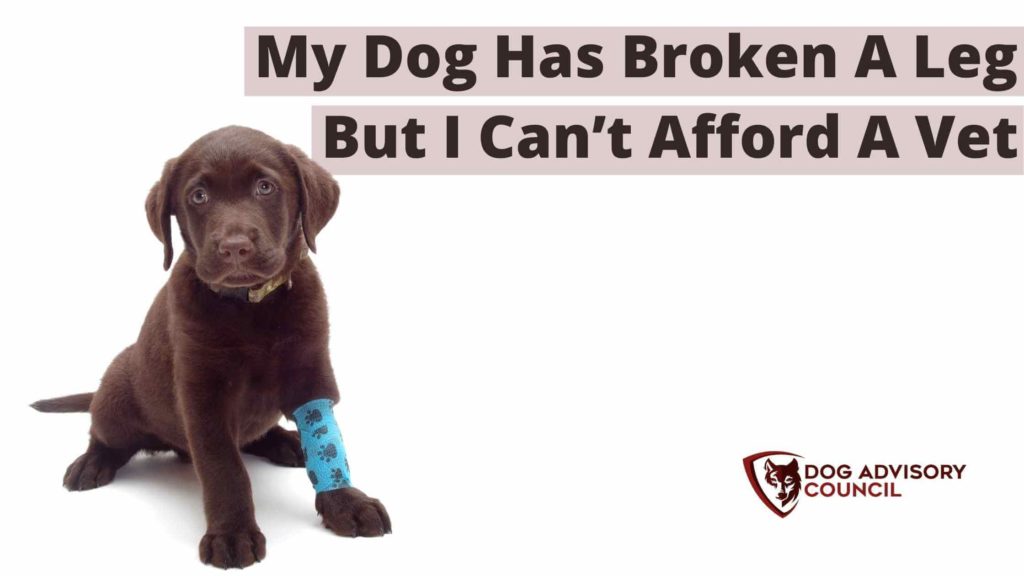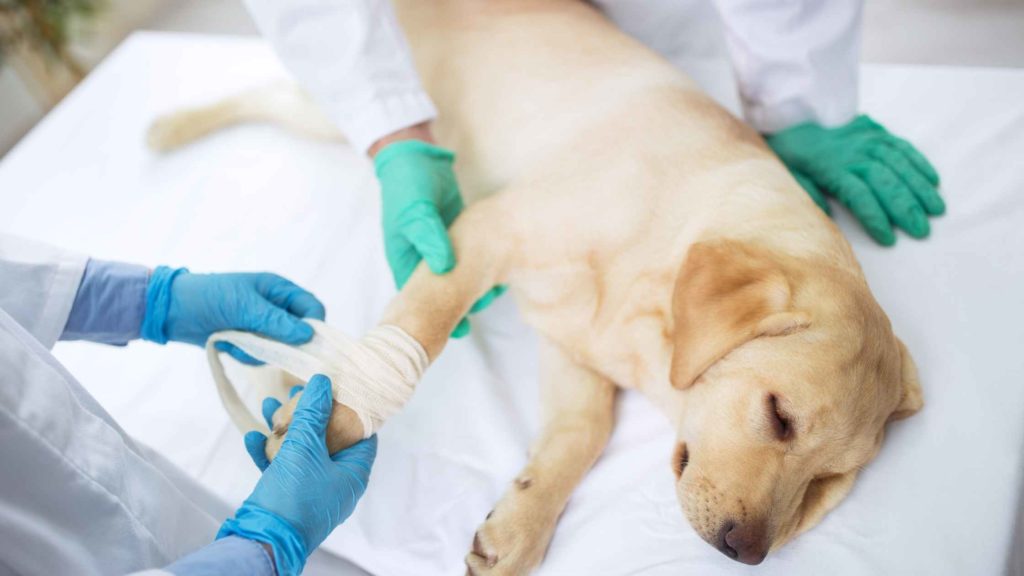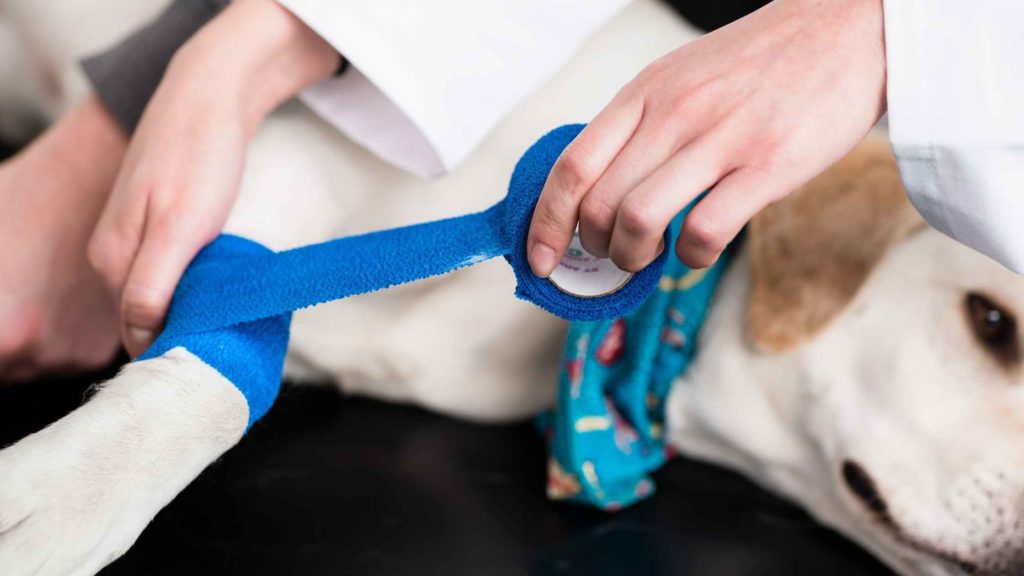
It’s a heartbreaking moment that can happen when we least expect it. What are your options? How can you help your dog? Read on for what you need to know.
Regardless of the reason or complexity of the break, you should let your vet know that you are in a tough spot when booking the appointment, not after. Alerting them to this beforehand gives them ample opportunity to offer support, guidance, and possibly some options for financing. It also shows professional respect, which will go a long way to helping them treat your dog quickly and easily. Most will help you make ends meet in whatever form they can.
Here are some tips to help you make the most out of it.
How much does a vet charge for a dog’s broken leg?
The charge for the vet care will depend primarily on what kind of break it was and how severe the break was. We’ll go more into detail later, but the general ballpark is that treatments cost start at $600, and those that require surgery often start at $2 000 and go up from there.
What do you do if you can’t afford the vet?
Let’s just say this upfront: vets are expensive, and a broken leg can be expensive, as you’ve learned. Sometimes the numbers just don’t work out in your favor no matter how much you want them to. If you are in this situation, here are the steps to follow:
- Call your vet to let them know about your dog
- Be honest on the phone
- Ask for recommendations
- Remember the goal
Call your vet to let them know about your dog
When you realize that your dog’s broken their leg, you suspect that this has happened, call your vet right away and let them know. The sooner that they can book you in, the better.
Be honest on the phone
This will be the most challenging part, but it’s essential. Before hanging up, let the person you are speaking with know your financial situation. Stay calm and professional and simply state the facts. They will be compassionate and understanding in return.
This step is crucial because it implies that you understand the bind and want to collaborate with them and work something out. There is nothing worse than popping this problem on them after the fact—more on that below.
Ask for recommendations
After putting this out for them to understand and acknowledge, immediately ask for recommendations. Most vets will work collaboratively with shelters and rescues. These will have emergency grants and other emergency funding available just for situations like these.
Others will offer up payment plan options or deferred payments, etc. The point is they will have several options available because this sort of thing is much more common than most realize.
Remember the goal
As much as it may not feel like it, and as awkward as it is to have this conversation, you and your vet are on the same team. Both want to see your dog pain-free and healthy. When you keep that goal in mind, you can effectively approach the entire conversation and procedure plan with the right attitude. In a situation as delicate as this, that goes a long way.

Can the vet keep my dog if I can’t pay?
This is everyone’s worst nightmare, and understandably so. As far as any logical situation is concerned, a vet can’t keep your dog “hostage” if you can’t pay your bill.
The worst situation is that they can refuse further treatment (including surgery, follow-up appointments, etc.) until the entire bill and surcharges are paid. There is also the possibility of a lawsuit in some situations.
However, you will bypass this entirely by being upfront about your finances. The example above is what would happen if you “conveniently” forget about your financial situation until after the vet appointment. At this point, they would be well within their rights to pursue whatever action they wanted.
Again, proper communication with a vet that you already know and trust will keep things friendly and professional on both sides.
Can my dog’s broken leg heal on its own?
A valid question when you think about those numbers above. If a dog’s broken leg is minor, it can heal on its own. However, you will need to know how minor it is and whether there are any possible compilations. It’s not recommended to assume it’s minor. Your vet will tell you more about how severe the break is.
How can I fix my dog’s broken leg at home?
There are treatments at home that you can consider if your dog is dealing with a minor break. However, you’ll want to do these at-home treatments only after you’ve got a vet’s sign-off. These treatments include:
- Keeping your dog as still as possible
- Treating your dog’s pain with medication
- Monitoring for any complications
- Keeping your dog calm
- Wrapping the leg to help the joint and limb stay in-line
This will help your dog heal quickly and with as few possible complications as possible.
I can’t afford vet treatment for my dog; what are my options?
So, now that we’ve covered a lot of details in general, let’s get a bit more specific on what those financial supports can turn out to be. Your main options will include:
- Pet insurance
- Support from those in your life
- Financing via an institution or a vet
- Charity or grants for emergency vet care
Pet insurance
This is exactly what it sounds like: health insurance for your pet. You can purchase plans through many carriers to help you afford emergency procedures. Many will include surgeries and pain medication, too. While you will need to have this before requiring it, of course, it’s something to think about seriously!
The cost of pet insurance can be influenced by insurer, breed, age, coverage type, and deductible options but will set you back anywhere from $29-$158 per month, depending on the level of coverage you want to consider.
Support from those in your life
From friends to family to bosses who can offer a cash advance on your salary, there are people all around you who can support you during this challenging time in your life. Most people are animal lovers, anyway, so they’ll be willing to help out. A little bit is all that it takes, most of the time.
Financing via an institution or a vet
It could be a loan or a line of credit or arranged monthly payments. The actual form will depend on where you go, but it can help you when you are in a pinch, and your dog just can’t wait until your next paycheck comes in!
Charity or grants for emergency vet care
There are grants and emergency funding just for this reason. While they aren’t advertised a lot, your vet or local charity can often put you in touch with those who offer them. While you’ll need to prove your financial need, it can help you breathe a sigh of relief to know that these options are out there.
How do you care for a dog with a broken leg?
We’re assuming that this will be a larger break rather than a minor one that can heal at home. In this case, there will be a few more steps to focus on for your dog’s wellbeing:
- Follow your vet’s advice
- Watch for complications
- Keep your dog calm and resting
- Give meds as recommended
All of these will help your dog stay relaxed, as comfortable as possible, and as still as possible. This is all you can do, much the same as a human with a broken bone! In this case, however, your dog will be confused since they don’t understand why they can’t go for a walk or a swim.
How can I ease my dog’s leg pain?
It’s hard to see your dog in pain. Especially because they are often confused as to why they are suddenly hurting. Help your dog’s pain by staying with him as much as possible and keeping him calm. Give him lots of love, if he wants it. If he would prefer you keep your distance, respect that too.
The most important thing is to focus on delivering meds as your vet recommends. They are recommended that way for a reason!
How can I tell if my dog’s leg is broken or just sprained?
The good news is that deciding whether your dog’s leg is sprained or broken is going to be about watching how they act with it.
A sprain
- Showing discomfort
- Paying attention to the leg by licking and smelling it
- Slow getting up
- Limping when walking on it
A break
- Showing clear pain markers
- Constantly trying to lick or pick at their leg (and guarding it)
- Swelling
- Bruising
- Grinding or popping
- Leg visually looking broken
The safest thing you can do is bring your dog to the vet for confirmation. It’s always best to be safe than sorry when it comes to a sprain versus a break, and your vet can give you some great advice on how to help your dog recover as quickly and as efficiently as possible.
Can a dog walk on a fractured leg?
Soe dogs can walk on fractured legs. It will depend on where the fracture is, how ad it is, and your dog’s comfort level. Don’t assume that a dog walking on a sore leg means it’s a sprain. A minor break can be serious if left untreated. See more on that below.
How do I know if my dog’s leg injury is serious?
Essentially, you’ll realize that your dog is uncomfortable. They’ll show pain, and they won’t be interested in doing anything. Combine this with a leg that just doesn’t look right, and you’ll need to get your dog booked into a vet. Until you’re told otherwise by a professional, assume your dog’s break is serious and treat it as such!
How do you wrap a dog’s broken leg?
If you are wrapping a dog’s leg with bandages, your vet will show you how to wrap it properly, but still, make sure that it’s not too tight or too loose. If you need a refresher, there are YouTube videos on it, too, to help you take proper care of your dog!

What can a vet do for a broken leg?
So, what actually is going to be the treatment for a broken leg? It mostly depends on the fracture and where the break was in the leg itself. Here are the terms that you can expect to hear:
- Incomplete fracture
- Complete fracture
- Transverse, oblique, and comminuted
- Open fracture
- Closed fracture
Incomplete fracture
This kind of fracture is not a clean break through the bone itself. Part of the bone has splintered, and part is still intact.
Complete fracture
This is the opposite. It would be a fracture where the bone has completely snapped all the way through.
Transverse, oblique, and comminuted
These words sound terrifying, but they just refer to the location of the break itself. They mean straight across the bone, diagonally across the bone, and a break in multiple places, respectively.
Open fracture
This means that the bone has broken so that there is a visual wound as a result. It could be a cut or even so severe that the bone is poking out.
Closed fracture
This is, of course, the opposite. It means that you can’t tell by looking at the leg that it’s broken, and there is no visual wound.
The treatment options
As you can imagine, the more severe the break is, the more complex the healing will be. Your options include:
- A cast
- An external device
- An internal device
- Amputation
Many people will ask if dogs get casts for broken bones, and the answer is yes! They can get casts and are recommended if the fracture is minor. These will keep the leg together to heal correctly, and it will also limit your dog’s movement, which is the whole point.
An external and/or internal device will be used when the break is complicated. The devices will help keep the bones and joints all in line properly as it heals. Not using those methods can mean permanent problems in your dog’s leg and a lot of unnecessary pain.
In some cases, amputation may be the best choice. If the break is so complex that it won’t heal properly, or there are concerns about gangrene or other complications, the vet may recommend amputation. It’s terrifying and drastic, but it can often offer more relief to your dog in the long term. Plus, dogs easily and quickly adapt to living with three legs!
Can a dog die from a broken leg?
This is understandably a question that you’ll have after reading words like “gangrene” and “amputation.” Yes, dogs can technically die from a broken leg — if it’s left untreated. This is why treatment as soon as you notice is essential.
Infections can easily lead to gangrene and necrosis (the tissue dying), which will require amputation. If left untreated, it can eventually cause organ failure, and your dog will die.
No matter how minor a break seems, bring your dog to a vet to ensure nothing is going on inside that you can’t see!
All in all
When booking the appointment for your dog’s broken leg, let the vet know that you are in a financially tight spot. They can make recommendations on easing the strain and still have your dog’s needs taken care of. They will always want what’s best for your dog, even if it means delaying the payments or adjusting them using grants and other donations where possible.
A vet will be your best option for your dog’s health and wellbeing. They will always have a few suggestions to help you out if you let them know that you’re in a tough spot.
Know someone worried about their dog and finances? Share this with them to help them see there is always hope!
